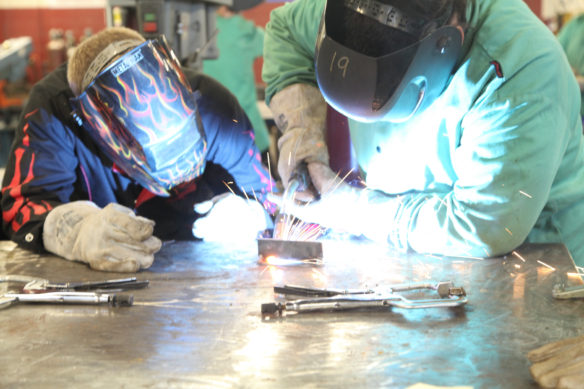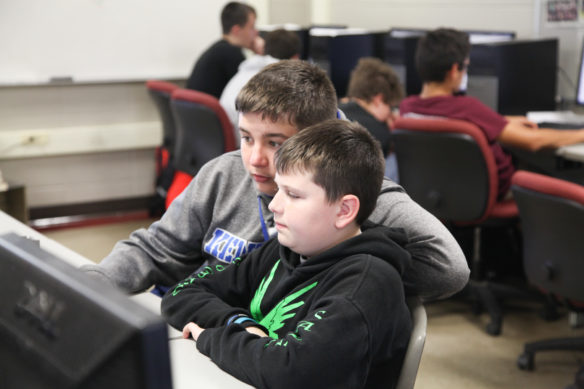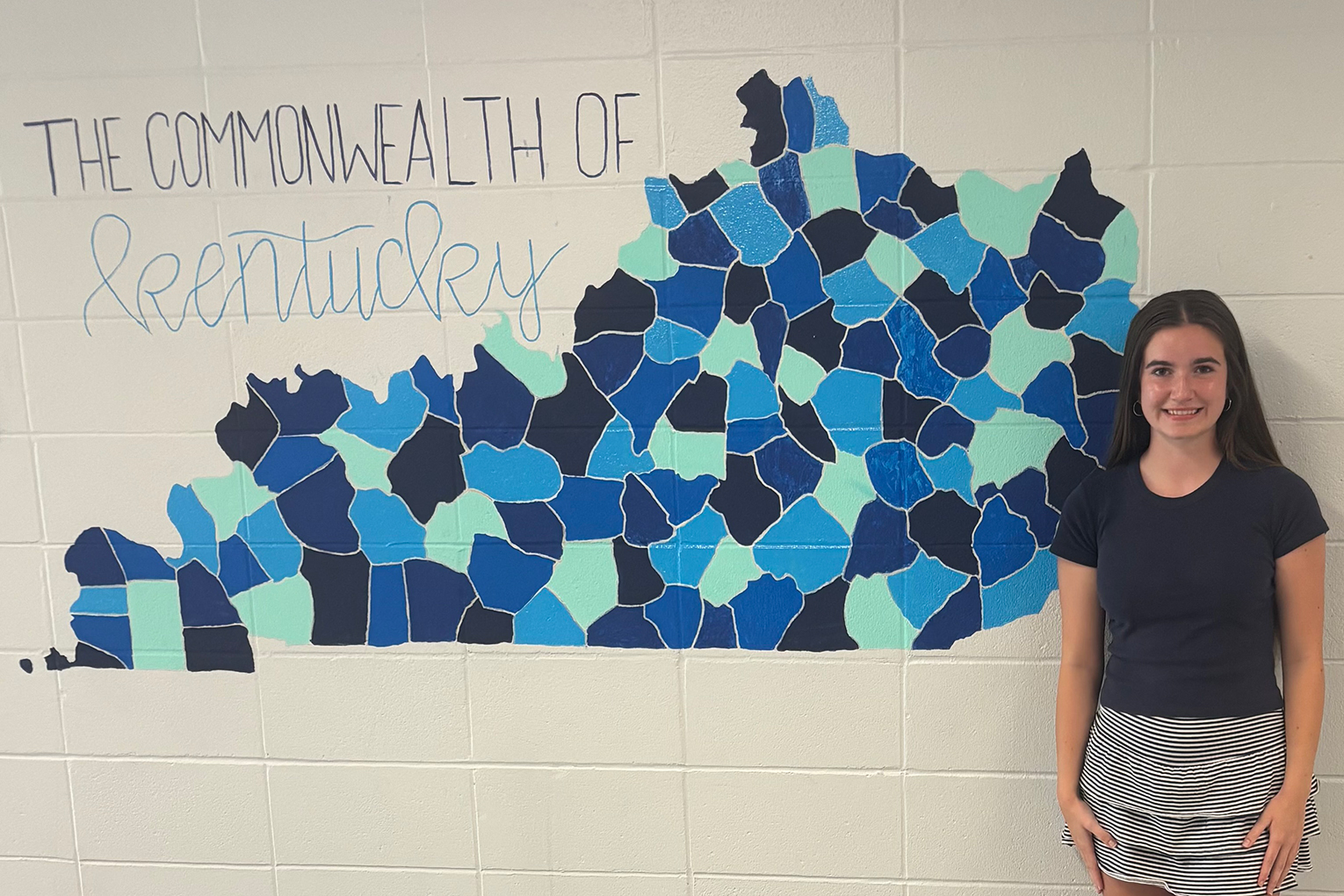
Jordan Tedrow, left, a welding instructor at Marion County Area Technology Center, watches as student Brianna Yolcum works. Yolcum is part of a group of 8th-grade students from Marion County Knight Academy who are taking a semester-long class at the ATC that gives them an up-close look at the school’s advanced manufacturing pathway.
Photo by Megan Gross, Oct. 15, 2018
By Mike Marsee
mike.marsee@education.ky.gov
Jordan Tedrow wasn’t sure turning a bunch of 8th-graders loose with his welding torches was a good idea.
Tedrow, a welding instructor at Marion County Area Technology Center, wasn’t the only one who had reservations about letting such young students get their hands on some of the equipment used in classes in the school’s advanced manufacturing pathway.
It has proven to be an idea worth trying, however, as more than 125 Marion County 8th-grade students have gotten an up-close look at that pathway as part of a rotation held at the ATC.
“It’s definitely an adjustment, but it’s actually gone really, really well,” Tedrow said.
The advanced manufacturing rotation is one of two elective classes at the ATC that have been created for 8th-graders at Marion County Knight Academy, the district’s 8th- and 9th-grade school. It was made possible when the district restructured its two middle schools prior to the 2017-2018 school year and 8th- and 9th-graders were moved to a building on the same campus as the ATC.
“Once we got all the 8th-graders here, we thought, ‘What can we do to help inspire them or inform them about opportunities in the ATC?’” Marion County ATC Principal Christina McRay said. “This school has been here since 1970, but there are still people who don’t know what we do. We decided that for this generation, we want to show them – not just tell them, but show them – the opportunities we have. Then we went to our community and business leaders and said, ‘What kind of career exploration should we be doing to get them ready to come work for you?’”
Middle school students have been exposed to the offerings at the ATC in other ways, but McRay said this program gives them a much better look at what they can do at the school and what it could lead to.
“They can get a little deeper into that learning,” she said.
Dana Tackett, the manufacturing program consultant for the Kentucky Department of Education, said Marion County ATC’s efforts to expose students early to career choices helps to counter myths about manufacturing jobs being dirty and dangerous and only suited for those unable to handle college.
“It also exposes students and parents to the high-salaried career pathways available in manufacturing,” Tackett said. “And maybe most importantly, it helps to change the ‘either/or’ mentality of technical education versus college. Instead, career and technical education along with college should be viewed as an ‘and’ proposition. Career pathways should be seen long term with multiple on and off ramps where careers can embrace both technical education and college, depending on career choices along the way.”
Students can choose the advanced manufacturing rotation as they would choose any other elective. The class lasts for one semester, and students come to the ATC for one period a day to spend 4 1/2 weeks in each of four areas: welding, machine tool technology, industrial maintenance and computer-aided design/computer-aided manufacturing.
They come in small groups of just 10 to 12 students each, and McRay said that helped alleviate some of her faculty members’ concerns about being able to manage students who weren’t quite as mature as high school students.
The students are given hands-on projects to complete in each of the four areas. For example, students in the machine tool area build a small lamp with a metal base.
“At every stop along the way, they have a project. Not only are they learning about the pathway, not only are they exposed to the lab, but they’re actually doing something,” McRay said.
Braydon Cissell, an 8th-grade student who was in his final days in the welding rotation, said that has made the class better than he thought it would be.
“I just like doing hands-on work. It’s really fun getting to interact with all your friends and making cool things,” said Cissell, who added that he likely will return to the ATC for classes next year.
McRay said 85 students came through the program last year, and about 80 percent of them returned to the ATC to take classes as freshmen.
“They go in on day one with a little more expertise than their classmates,” she said. “And the instructor knows the student, they know at least a little bit of their capabilities and where to start with them.”
McRay said it didn’t take her instructors long to get on board and to see the benefits of the program.
“It’s a learning curve,” Tedrow said, “but the students do really well, and who doesn’t like playing with fire?”

Dayton Sims, left, helps classmate Blake Summey as they work on designing three-dimensional models of vehicles in an introduction to STEM class for 8th-graders at Marion County Area Technology Center. The class introduces students to engineering and the Project Lead the Way engineering curriculum.
Photo by Megan Gross, Oct. 15, 2018
Down the hall from the welding laboratory, some of the same welding students also had the opportunity to design three-dimensional models of vehicles on computers in Greg Conley’s classroom.
Conley’s introduction to STEM class exposes the students to engineering and the Project Lead the Way (PLTW) engineering curriculum that Conley teaches 9th- through 12th-grade students.
The semester-long class gives about 25 students at a time a basic understanding of engineering. Conley, the lead PLTW teacher at Marion County High School, said it also can give students an idea of whether engineering is right for them.
“By the time they leave, I want to have a very good understanding of whether mathematically, work ethic-wise and conceptually they can do this,” Conley said. “And I’ll tell them straight up: if I don’t feel like you’re engineering material, there are 50 other careers that don’t go all the way up the ladder that they could go up to and get off. What we’re doing here is helping that understanding tremendously, because these kids are getting exposed in 8th grade to things they don’t usually see until sophomore year.”
McRay said she would like to see some variation of the program made available to 8th-graders in Washington County, the other district served by Marion County ATC, and she hopes it’s possible to someday expand to the ATC’s other pathways as well.
McRay said it’s important to make students aware of what they can learn and do through the school.
“We don’t want to be selfish and say every kid has to come to the ATC,” she said. “It’s not for every student, but we want them to have the opportunity to see if it is for them and just explore a little bit.”
MORE INFO …
Christina McRay christina.mcray@marion.kyschools.us
Jordan Tedrow jordan.tedrow@marion.kyschools.us









Leave A Comment